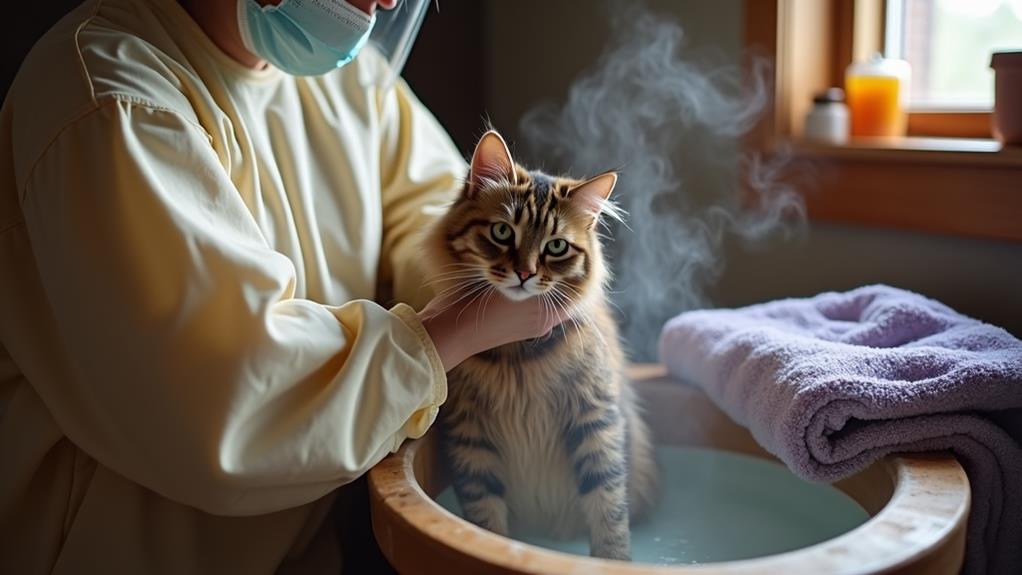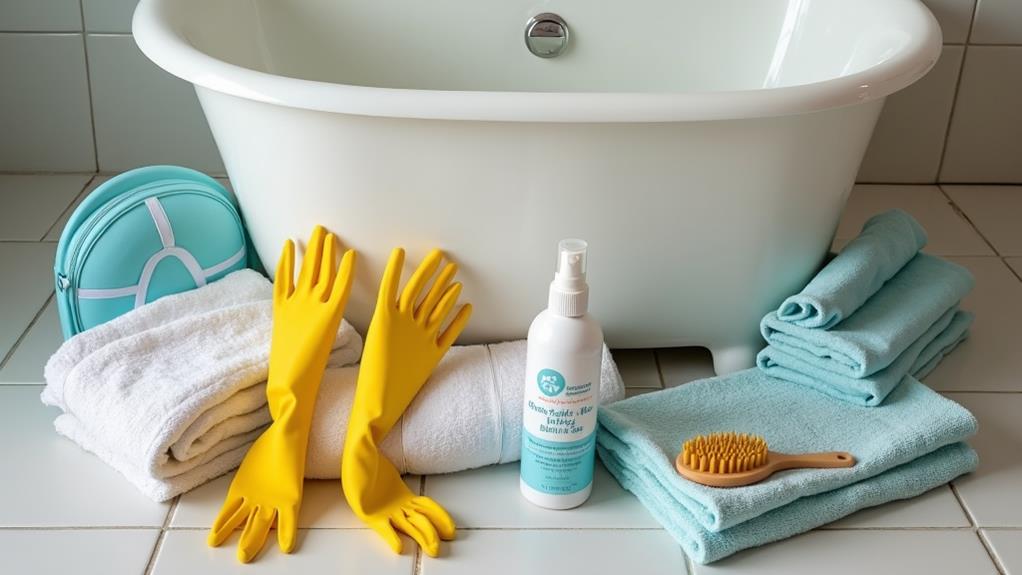How to Bathe a Feral Cat: Safety Tips for Handling a Wild Cat

Bathe a feral cat with caution by gathering your supplies initially: cat-specific shampoo, soft towels, and a non-slip mat. Choose a quiet, warm space and fill a basin with lukewarm water. Wear gloves to protect yourself from potential bites and scratches. Work with a helper for extra safety, and keep all items within easy reach. Wet the cat gently, avoiding its eyes and ears, and wrap it securely in a towel to limit movement. After applying shampoo, rinse thoroughly and monitor for stress. Post-bath, guarantee the cat's comfort in a warm, quiet space. Uncover more effective techniques by continuing.
Preparing for the Bath
Before you start bathing a feral cat, preparation is key to guaranteeing a smooth process. Initially, gather all necessary supplies to create a safe and efficient environment. You'll need a gentle, cat-specific shampoo, plenty of towels, and a non-slip mat to prevent any accidents. These items will help keep the cat secure and reduce any stress during the bathing process.
Choose a warm, quiet space for the bath. This will minimize stress and make the feral cat feel more secure. A calm environment is fundamental in helping the cat remain as relaxed as possible. Set up a basin or tub that's easily accessible for the cat. When you're ready to begin, gently wet the cat using lukewarm water. This approach is vital to avoid shocking the cat's system and guarantees a more gentle experience.
Use a damp washcloth to clean sensitive areas like the face, being careful to avoid direct contact with the eyes and ears. Having a second person assist can be invaluable in keeping the cat calm and secure, allowing you to focus on the bathing process itself. This preparation will help make bathing a feral cat a more manageable task.
Safety Precautions
Handling a feral cat requires caution and a few important safety precautions to guarantee both your safety and the cat's well-being. Initially, always wear gloves. Feral cats may react unpredictably to the stress of a bath, and gloves provide fundamental protection against potential bites and scratches. Creating a calm environment is critical, so confirm the bathing area is quiet and free from distractions. This helps prevent the cat from becoming overly stressed, making the process smoother for both of you.
Before starting the bath, gather all necessary supplies, like towels, cat shampoo, and a non-slip mat, within reach. This preparation means you won't have to leave the cat unattended, minimizing stress and maintaining a secure setting. Use a towel to wrap the cat securely, forming a "cat sanctuary" that helps reduce movement and panic. This tactic keeps the feral cat calmer and more manageable during the bath.
If possible, get assistance from another person. Having someone help hold the cat securely guarantees the animal remains calm and safe throughout the process. These safety precautions not only protect you but also contribute to a less traumatic experience for the feral cat.
Bathing Supplies Needed

After confirming your safety and the cat's comfort with the necessary precautions, it's time to gather the right supplies for bathing a feral cat. The bathing process can be a challenge, but having the right items on hand will make it smoother and safer for both you and the cat. Initially, choose a gentle, cat-specific shampoo to prevent skin irritation and guarantee the feral cat's safety. Regular shampoos for humans or dogs can be too harsh, so it's vital to pick one made specifically for cats.
To help the cat feel secure and reduce anxiety during the bath, use a non-slip bath mat or towel. This provides stability and comfort. You'll also need several soft towels to dry the cat thoroughly afterward, maintaining warmth and comfort.
Here's a quick checklist to confirm you're ready:
- Cat-specific shampoo: Protects the cat's skin and fur.
- Non-slip bath mat/towel: Helps the cat feel safe and secure.
- Soft towels: Important for drying and warmth.
Step-by-Step Bathing Guide
Starting with a calm and prepared mindset, make certain the bathing area is secure and equipped with a non-slip mat. This guarantees feral cats feel more stable and reduces the chance of slipping. Gather your supplies, including lukewarm water, cat-specific shampoo, towels, and a soft cloth.
Begin by gently wetting the cat's fur with lukewarm water, taking care to avoid the eyes and ears. This gentle wetting helps reduce stress and discomfort. Apply the cat-specific shampoo, working it from neck to tail while avoiding sensitive areas like the face. This step is essential to prevent irritation and guarantee the cat's comfort. Rinse thoroughly to remove all shampoo residue, which could otherwise cause skin issues.
As you work, monitor stress levels closely. Feral cats may become agitated, so consider using calming techniques like pheromone sprays to help ease anxiety. After rinsing, wrap the cat in a towel to absorb excess water and provide warmth. This wrapping technique not only dries the cat but also helps them feel secure and comfortable post-bath. Throughout the process, remain patient and attentive, guaranteeing the feral cat's safety and well-being.
Post-Bath Care

Why is post-bath care vital for a feral cat's well-being? After the stress of a bath, a feral cat needs a calm environment to recuperate. The bath can be an overwhelming experience, so providing proper post-bath care is key for reducing anxiety and promoting recovery.
First, create a warm, quiet space where the cat can feel secure. This helps minimize their stress, allowing them to settle down. Offering a soft towel or blanket gives them the comfort they need to feel safe and protected.
Second, closely monitor the cat for any signs of discomfort or unusual behavior. Feral cats can react unpredictably, and it's significant to address any issues promptly to guarantee their well-being.
Professional Help and Resources
When bathing a feral cat, seeking professional help can make the process safer and less stressful for both you and the cat. A veterinarian or professional groomer is equipped to handle feral cats with care, guaranteeing safe handling and minimizing stress. Local animal shelters and rescue organizations are invaluable resources, often offering access to low-cost veterinary services. They may also guide you towards community programs that focus on Trap-Neuter-Return (TNR) initiatives, which help manage feral cat populations and reduce the need for frequent baths.
Online veterinary services can be a quick way to get advice on best practices for bathing feral cats. These platforms provide guidance on evaluating a cat's health before any cleaning efforts. Establishing a relationship with a local vet is beneficial, as it supports ongoing care strategies, including routine health evaluations and vaccinations tailored for feral cats.
Don't hesitate to reach out to community programs that provide resources for feral cat care. By tapping into these professional help and resources, you'll be better prepared to handle feral cats safely and promote their well-being while maintaining your own safety and peace of mind.




